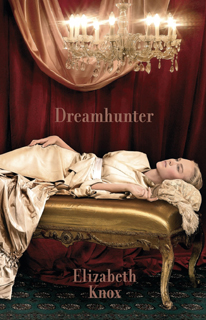Sigmund Freud believed dreams were a pathway to our unconscious. Carl Jung held that dreams could be interpreted based on several universal symbols or images. The Bible records God speaking to numerous people through dreams, men and women like Joseph, Daniel and Mary.
Dreams are a fascinating and mysterious part of our lives. They can reveal prophecies and promises. They can cause us to wake in terror. In our sleeping state we experience stories and images that can frighten or delight. In our waking moments the memory of these nightly visions slips away from us.

In Elizabeth Knox's spellbinding novel, Dreamhunter, dreams are more than a physiological part of sleep they are a cultural phenomenon.
Set in 1906, the novel takes place within a fictional country that could readily be England or any affluent European nation. What distinguishes Knox's imagined land from nations of history is a mysterious element of geography. Within the country exists a region known as "The Place'. The Place can only be entered by the very gifted few, men and women known as Dreamhunters.
Once caught, a dream lasts several days before fading. During this time dreams are performed to audiences at theatres and opera houses. They are sometimes even used at hospitals for medicinal purposes. Given the ephemeral nature of the dreams themselves they need to be captured time and again. And for the especially skilled dreamhunters dreaming can be a lucrative business. But like everything even dreams can be used for dark purposes.
Laura Hame and Rose Tiebold are teenaged cousins from two of the most famous dream hunting families. As The Place is off limits to children they must wait until they turn fifteen to see whether they have inherited their parents' gifts. But what awaits them is not just the promise of fame and fortune but something altogether more sinister.
In Dreamhunter Knox creates an intriguing reality which is both recognisable and foreign. Despite the novel's divergence from history and reality certain things of our world remain, notably Christianity. One historical figure in Knox's imagined society is that of Lazarus " the friend Christ raised from death. While mention of St Lazarus occurs primarily in a cultural context it is nonetheless significant; the heart of the novel is about death and renewal, demise and redemption. Excepting Christ himself, who better to evoke the fragile interplay between life and death than Lazarus?
After a disappointing experience with Elizabeth Knox earlier novel, the multi award winning The Vintner's Luck I was somewhat ambivalent about reading Dreamhunter. However this imaginative work is both beautifully written and a compelling read.















